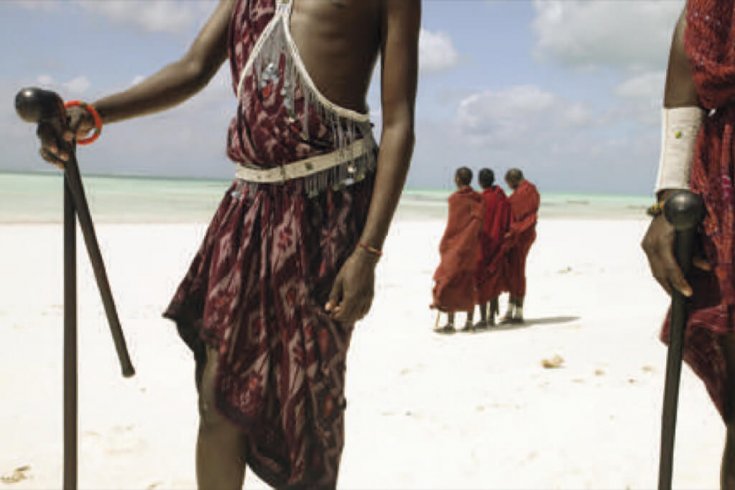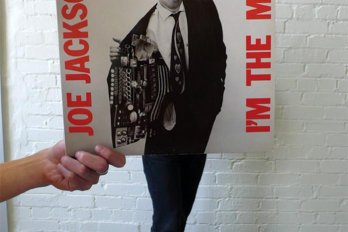I knew of the Masai long before I met them. They were the majestic warriors of the East African savannah, their bodies so thin and tall they barely cast a shadow in the scorching sun. They were the romance of humanity’s birth continent, among the few on the planet who still live by ancient rites the rest of us have long forgotten. So when I learned recently that the modern scourge of hiv/aids might wipe them out, it seemed important to travel to their lands on the edges of the teeming Serengeti.
It was my honeymoon. My husband and I landed in the north of Tanzania, near Mount Kilimanjaro, and made our way to the village of Mto wa Mbu (“mosquito river” in Swahili), where Charles Luoga of the Institute of Cultural Affairs, a non-governmental organization, has set up one of the few programs in East Africa to deal specifically with aids and the Masai.
We could hardly wait for our first glimpse of the iconic tribespeople, and it wasn’t long in coming, only a few hours from the airport at a handy roadside attraction set up for tourists like us. About a dozen Masai women dressed in red, neck hoops bouncing up and down on their chests, danced and sang a song about their “Masai market.” We posed with them, took pictures, and bought jewellery. Astonishingly, all of the women wore beaded hiv/aids pins.
Mto wa Mbu is down a new paved road, just a few kilometres from Olduvai Gorge, the fabled site where Mary Leakey unearthed fossil remains of some of the world’s oldest human ancestors. The Masai don’t live in the town, Luoga explained. Rather, clustered in boma, groups of mud and thatch homes spread out on the wind-torn plains that surround it.
It’s impossible to know how many Masai live in Monduli, the district that includes Mto wa Mbu, or, for that matter, how many altogether inhabit Tanzania and Kenya. Estimates range from 600,000 to over a million. Draped in red shawls, Masai men roam between the two countries in search of grazing land for their thirsty herds of cattle, keep to themselves, and are often missed by government statistics gatherers. Indeed, while there are examples of certain communities embracing change (e.g., the adoption of Christian burial practices), for the Masai in general, traditions and age-old cultural practices tend to be adhered to. Around Mto wa Mbu, all but the most critically endangered babies are born on the boma, and the dead, according to Luoga, are ritually put into the bush for the hyenas. (If the hyenas are not quick enough, Luoga said, the Masai smear the bodies of their dead with goat fat to attract them.) There are no official records of births, deaths, or local population size.
It’s also difficult to determine how many are affected by hiv/aids. Dr. A. S. Swai, a former medical officer of health for the Monduli district, told me that about 14 percent of all tribespeople in Monduli are hiv positive, roughly twice the Tanzanian average. He could only guess at the number of hiv-positive Masai, but there are troubling stories that they might be especially vulnerable, perhaps even catastrophically so.
As we drove back to Mto wa Mbu, Luoga pointed to a group of huts in the distance. Each boma is the household of an extended family, and the number of huts roughly indicates how many wives the patriarch has. Most have several. The richest have a dozen. Luoga knew of one who had twenty. Masai men pride themselves on having enough wives to share with others in their age group, both locally and from other Masai land, and some Masai women also have lovers. As a result, Masai often have dozens of sex partners, putting them at considerable risk of contracting hiv. Many Masai girls become sexually active when they are just seven or eight years old, so it’s possible some will become infected and die before they can bear their own children.
The next day, we arrive at the turquoise-walled courtyard of the Institute of Cultural Affairs in Mto wa Mbu to meet some of Luoga’s local volunteers. (Naseriani Mollen, a Masai woman, walked twelve kilometres to attend.) Some are hiv positive; others keep promising to be tested. However, while antiretroviral drugs are free in Tanzania, they don’t seem to be reaching the Masai: only one person in this group is taking the drugs.
Samuel Laizer, with holes the size of silver dollars in his earlobes and, like many Masai, missing his left front tooth — a precaution against lockjaw, to allow an entry point for herbal medicines from traditional healers — told us that many Masai don’t believe hiv/aidscan affect them. There is increasing awareness of the disease, but a general reluctance to take necessary precautions, if these are even available. Masai men, for instance, are vehemently opposed to using condoms. Laizer described visiting a family nursing a sick relative, probably in the advanced stages of aids. The wife met Laizer at the entrance to her boma and told him her husband was asleep. When he returned the next day, she offered the same reason. On the third day, he snuck into the boma and witnessed a witch doctor making circles around the husband’s head with a chicken. Within a week, the man died from lack of food and water. He had not been attended to because his family thought he was bewitched.
It can be tough to get treatment in this part of Africa, even if you admit you need it. Mto wa Mbu has the sole health centre in a ninety-kilometre radius, and only here can people get antiretroviral drugs. The centre is run by the Lutheran Church, and, with its sprinklers and planted flowers — all but unheard of in a district so dry that people and cattle drink from the same muddy ditches — it struck me as an oasis of sorts. On the day we visited, the doctor, Steven Mchau, and his staff were treating fifty-one patients with antiretrovirals. Not many were Masai, however; apparently, they tend to be on the point of death before they come to the clinic, if they come at all.
Sara Lomayani, a Masai who moved off the boma and married a Lutheran minister, is the clinic’s main liaison with the Masai. Her task is to meet with Masai women and try to dissuade them from circumcising their daughters, as well as to educate them about using condoms. It is no easy task. Dealing with the female circumcision issue is even more difficult than promoting condom use. The Masai practise a particularly mutilating form of the ritual, removing the clitoris and much of the labial tissue with razors. Lomayani shuddered when she told me about the damage she had seen. Circumcision frequently leads to wounds so deep they never heal, and to lifelong infections. It also renders Masai women even more vulnerable to hiv. The practice is now illegal in Tanzania, and so, according to Lomayani, instead of performing the operation when the girls reach puberty the Masai avoid prosecution by doing it when they are toddlers. “I am crying for the Masai,” she says. “They are all going to die. In five or ten years, we’ll forget they existed.”
Dr. Simon Ngoka, who helps organize home-based care for the sick, helped explain why the Masai in particular are so vulnerable. There is a new highway nearby that runs for hundreds of kilometres south. It was built with Japanese money, to help tourists reach the famous Ngorongoro Crater, the Olduvai Gorge, and the Serengeti. Forced off their cattle-grazing lands by nearly ten years of drought and reluctant to learn other forms of agriculture, many Masai men worked on the road. They picked up hiv from sex trade workers along the highway and took the disease home to what had been, up to that point, closed sexual communities (i.e., Masai almost always had sex only with other Masai). Ngoka said he believes the Masai need a targeted hiv/aids education program if they are to survive. “It will be very difficult to avoid hiv if you are Masai,” he said. “The big phenomenon is coming.”
But how do you reach these intensely private, ritualistic people? By way of reply, Luoga took me on another drive through Masai lands, this time to Selele. The sprawling village is about an hour’s journey by rutted road from Mto wa Mbu, past giraffes blinking lazily by the side of the road and herds of skeletal cattle, and through a landscape so water starved and overgrazed that even weeds fail to sprout. Traditionally, boma are barely tall enough to stand up in and have neither windows nor chimneys. Nonetheless, women cook on wood fires inside the huts, and many develop lung cancer or go blind because of the soot and smoke. (The men leave the boma at first light to be with other men and do not return until dark.) Unable to change Masai behaviour around their sexual practices directly, Luoga came up with an alternative plan involving boma.
He raised a few thousand dollars to renovate approximately 150 Masai huts by installing chimneys and windows in them. At first, there was tremendous resistance by both women and men, but there were converts. Happiness Lemuriet was one. Tall and stately in her white headdress and two sets of earrings, she welcomed me into her mud dwelling. It was immaculate and featured a mattress — something Luoga had never seen before in a Masai hut — a clear indication that she was her husband’s favourite wife. Her renovated hut had three windows, a hearth, and a chimney. Before, she told me, her ceiling was covered in soot, and people inside could not see one another. She no longer has a cough, and because the new chimney was so efficient she was using 70 percent less firewood, which meant less time searching the countryside for the scarce resource. Her children could read and write inside, as there was natural light. Lemuriet is a trailblazer who encouraged others in this village of 2,400 to join the program. Many remained suspicious, but at the time of our visit there were twenty-five huts with chimneys. Today, there are 150.
As we left Selele, Luoga explained that if he could show the Masai they could trust him on chimneys, then they might trust him about hiv/aids. But this is proving difficult, and, on a very sombre note, Luoga said he is bearing witness to a disaster in the making.
After Mto wa Mbu, I travelled to Zanzibar, Tanzania’s island playground, where I stayed for $168 a night in a five-star hotel overlooking a white, sandy beach and the Indian Ocean. The sheets were thick and crisp, and the room had fresh-cut flowers and a basket of tropical fruit. I bathed with scented bubbles to wash away the dust of Mto wa Mbu, put on my white linen, and sat on the balcony watching a parade of dhows on the blue ocean. Then I went downstairs to the bar for a glass of chilled white wine from the Western Cape.
Later, as my husband and I wandered through ancient Stone Town’s beachside park — where the night blackness is lit by scores of barbecued fish stalls — we spotted two Masai men. They were sprawled out on the ground in their red shawls, holding the sticks that ought to have been used for herding cattle and fending off lions on the savannah. They were laughing and limb sloppy, maybe drunk. At their feet were knick-knacks and jewellery, made, no doubt, by Masai women back home on a boma. They gestured to us, urging us to buy, to take home an artifact representing these proud tribespeople.
Read online correspondent Arno Kopecky’s Notes from Nairobi blog, visit The Walrus Blogs.


